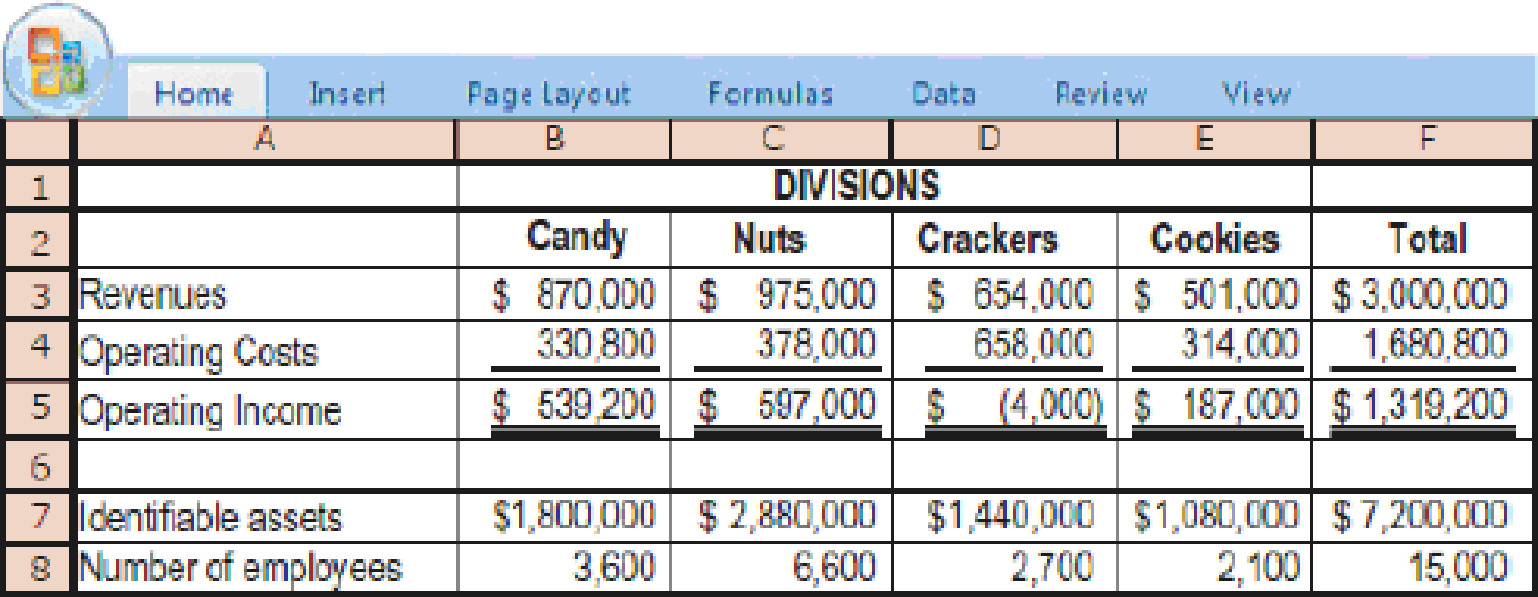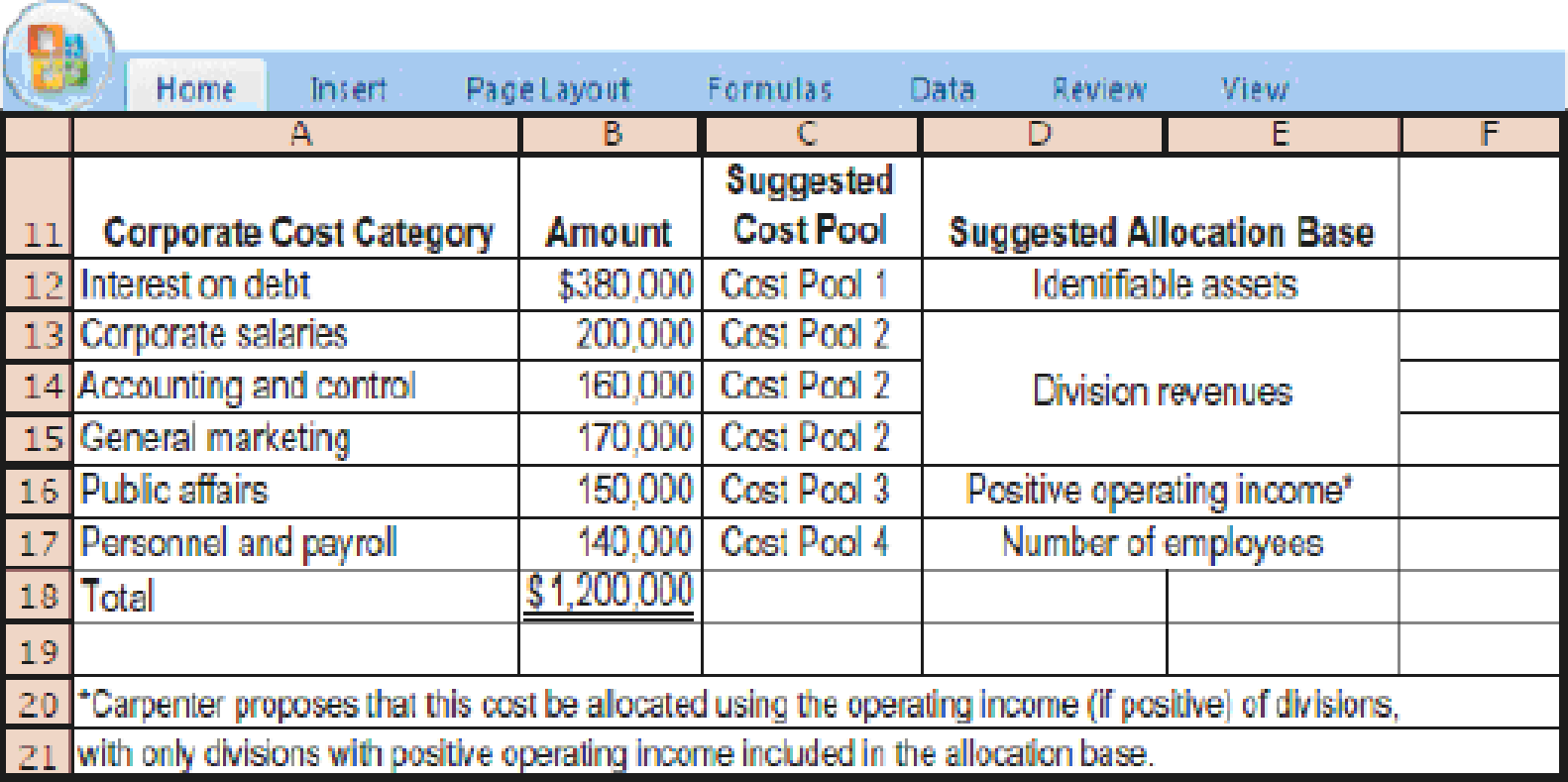
Allocation of corporate costs to divisions. Cathy Carpenter, controller of the Sweet and Salty Snacks is preparing a presentation to senior executives about the performance of its four divisions. Summary data related to the four divisions for the most recent year are as follows:

Under the existing accounting system, costs incurred at corporate headquarters are collected in a single cost pool ($1.2 million in the most recent year) and allocated to each division on the basis of its actual revenues. The top managers in each division share in a division-income bonus pool. Division income is defined as operating income less allocated corporate costs.
Carpenter has analyzed the components of corporate costs and proposes that corporate costs be collected in four cost pools. The components of corporate costs for the most recent year and Carpenter’s suggested cost pools and allocation bases are as follows:

- 1. Discuss two reasons why Sweet and Salty Snacks should allocate corporate costs to each division.
Required
- 2. Calculate the operating income of each division when all corporate costs are allocated based on revenues of each division.
- 3. Calculate the operating income of each division when all corporate costs are allocated using the four cost pools.
- 4. How do you think the division managers will receive the new proposal? What are the strengths and weaknesses of Carpenter’s proposal relative to the existing single cost-pool method?
Want to see the full answer?
Check out a sample textbook solution
Chapter 14 Solutions
COST ACCOUNTING
- What is the amount of the conversion costs?arrow_forwardSuppose the following two independent investment opportunities are available to Fitz, Inc. The appropriate discount rate is 12%. Year Project Gamma Project Theta 0 -$2,500 -$4,100 1 1,300 800 2 1,100 2,100 3 900 3,600 Calculate the profitability index (PI) for each project. Which project should the company accept based on the PI rule? Consider the following cash flows on two mutually exclusive projects for a company. Both projects require an annual return of 15%. Year Project A Project B 0 -$725,500 -$1,450,900 1 275,000 889,000 2 413,800 647,330 3 382,075 554,280 As a financial analyst for the company, you are asked the following questions: If your decision rule is to accept the project with the higher IRR, which project should you choose? Because you are fully aware of the scale problem associated with IRR rule, you calculate the incremental IRR for the cash flows. Based on your…arrow_forwardNeed helparrow_forward
- Financial Accountingarrow_forwardNeed help with this financial accounting questionarrow_forwardPurple Corp. reported under GAAP for the year ended 12/31/2024 depreciation expense $45,000 and warranty expense $25,000. During 2024, $5,000 in warranties were serviced, and the remainder is estimated to be serviced over the following 4 years. Under the tax code, depreciation for 2024 would be $60,000. Assuming these are the only differences between GAAP and the tax code, how much would be reported as a deferred tax expense or deferred tax benefit on the income statement for the year ended 12/31/2024 if the future tax rate will be 30%? A A deferred tax expense of $4,500 B A deferred tax benefit of $6,000 C A deferred tax expense of $1,500 D A deferred tax benefit of $1,500arrow_forward
 Managerial AccountingAccountingISBN:9781337912020Author:Carl Warren, Ph.d. Cma William B. TaylerPublisher:South-Western College Pub
Managerial AccountingAccountingISBN:9781337912020Author:Carl Warren, Ph.d. Cma William B. TaylerPublisher:South-Western College Pub Cornerstones of Cost Management (Cornerstones Ser...AccountingISBN:9781305970663Author:Don R. Hansen, Maryanne M. MowenPublisher:Cengage LearningPrinciples of Accounting Volume 2AccountingISBN:9781947172609Author:OpenStaxPublisher:OpenStax College
Cornerstones of Cost Management (Cornerstones Ser...AccountingISBN:9781305970663Author:Don R. Hansen, Maryanne M. MowenPublisher:Cengage LearningPrinciples of Accounting Volume 2AccountingISBN:9781947172609Author:OpenStaxPublisher:OpenStax College Financial And Managerial AccountingAccountingISBN:9781337902663Author:WARREN, Carl S.Publisher:Cengage Learning,
Financial And Managerial AccountingAccountingISBN:9781337902663Author:WARREN, Carl S.Publisher:Cengage Learning, Principles of Cost AccountingAccountingISBN:9781305087408Author:Edward J. Vanderbeck, Maria R. MitchellPublisher:Cengage Learning
Principles of Cost AccountingAccountingISBN:9781305087408Author:Edward J. Vanderbeck, Maria R. MitchellPublisher:Cengage Learning




